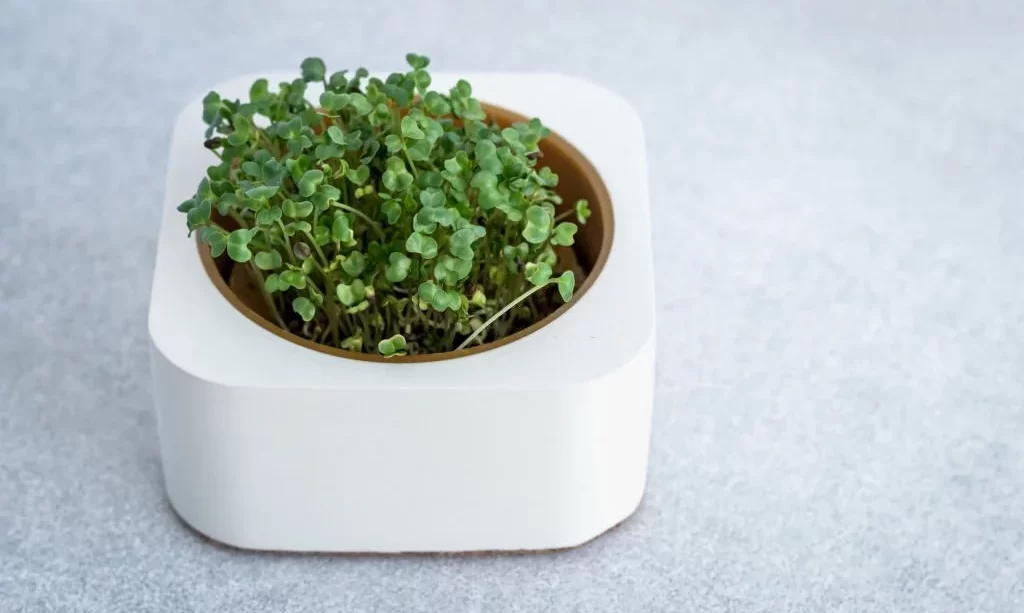Container gardening offers a versatile and space-saving way to grow your favorite vegetables, and broccoli is no exception. Whether you have limited garden space or simply want the convenience of having fresh broccoli right at your doorstep, growing broccoli in a pot can be a rewarding endeavor. In this comprehensive guide, we’ll explore the step-by-step process of successfully cultivating broccoli in a container. From choosing the right container to harvesting your homegrown broccoli, you’ll discover that with the right knowledge and care, anyone can enjoy the benefits of container-grown broccoli.
- Burpee exclusive. Tight blue-green heads stand up against the heat of summer. Well leafed plants yield these 6-8″ diameter heads and 5-10, 1″ side shoots as well
- Each packet contains 400 seeds
- Sow indoors 6-8 weeks before average last frost date using a Burpee seed starting kit. Transplant to the garden 4 weeks after the average last frost date. Harvest in 71 days
- Plant Height is 14″. plant spread is 18″. yields 6-8″ heads
- Annual for all growing zones from 1-11. Sunlight exposure = full-sun
Choosing the Right Container
The first crucial step in growing broccoli in a pot is selecting the right container. Here’s what you need to consider:
- Container Size: Opt for a container that provides ample space for your broccoli plants to grow. A container with a diameter of at least 12 inches (30 cm) is recommended to accommodate the root system and allow proper growth.
- Depth: Broccoli has deep roots, so choose a container that is at least 12 to 18 inches (30 to 45 cm) deep to ensure healthy root development.
- Material: Containers can be made from various materials, including plastic, ceramic, or wood. Ensure that the container is made of a durable material that can withstand outdoor conditions.
- Drainage: Proper drainage is crucial to prevent waterlogged soil, which can harm your broccoli plants. Look for containers with drainage holes in the bottom or be prepared to drill holes if necessary.
- Accessibility: Consider the ease of moving the container, especially if you plan to bring it indoors during extreme weather conditions or to extend the growing season.
- Appearance: Choose a container that suits your aesthetic preferences and complements your garden or outdoor space.
By selecting the right container, you create a conducive environment for your broccoli plants to thrive. In the following sections, we’ll delve into the details of preparing the potting mix, choosing the right broccoli variety, and the essential steps for successful broccoli cultivation in a pot.
- Premium stoneware is designed for everyday use
- Colorful glaze is nonporous, non-reactive and resistant to chips, scratches and stains
- Virtually nonstick glazed surface is ideal for quick clean-up, and resists cracking and crazing
- Safe for dishwasher and metal utensils
Selecting the Broccoli Variety
When it comes to growing broccoli in a pot, choosing the right variety is a crucial decision. Here are some considerations to help you select the ideal broccoli variety for container gardening:
- Compact Varieties: Opt for broccoli varieties that are known for their compact growth habits. These varieties are well-suited for containers and will thrive without overwhelming the limited space.
- Miniature or Baby Broccoli: Consider growing miniature or baby broccoli varieties, such as ‘Aspabroc’ or ‘Artwork.’ These types produce smaller heads and are perfect for containers.
- Climate Compatibility: Choose a broccoli variety that is well-suited to your local climate and growing season. Some varieties are better suited for cool weather, while others thrive in warmer conditions.
- Days to Maturity: Pay attention to the “days to maturity” information for each variety. This will help you plan your planting schedule and harvest at the right time.
- Disease Resistance: Check if the chosen variety has any resistance to common broccoli pests and diseases. This can make your container gardening experience more manageable.
By selecting the right broccoli variety for container gardening, you set the stage for a successful and bountiful harvest.
Soil Preparation and Potting Mix
Preparing the right potting mix is essential for growing healthy broccoli in a container. Follow these steps to create the ideal soil environment:
- Container Choice: Ensure your container has proper drainage holes to prevent waterlogged soil, which can lead to root rot. If your container lacks drainage holes, consider drilling them at the bottom.
- Potting Mix: Use a high-quality potting mix or create your own by combining potting soil, compost, and perlite or vermiculite. This mixture provides good aeration and drainage, which is crucial for broccoli’s root health.
- Nutrient Enrichment: Broccoli plants require essential nutrients. Mix in a balanced, slow-release fertilizer according to the package instructions to provide a steady supply of nutrients as the plants grow.
- pH Levels: Check the pH levels of your potting mix. Broccoli prefers slightly acidic to neutral soil with a pH range of 6.0 to 7.0. Adjust the pH if necessary using lime or sulfur.
- Fill the Container: Fill your chosen container with the prepared potting mix, leaving enough space at the top for watering.
Proper soil preparation and the right potting mix create a favorable growing environment for your container-grown broccoli. In the following sections, we’ll explore planting broccoli seeds or seedlings in your container and provide guidance on care, maintenance, and harvesting.
- 🌱 ALL NATURAL MIX Suitable For Use On Edible Plants like FRUITS & VEGETABLES
- 🍎 MYCORRHIZAE ENRICHMENT — Aids Root Growth as well as increased Nutrient Absorption for your Plants
- 💧EASY-TO-MANAGE DRAINAGE — Blended with Perfect Plants Perlite
- 🏺 BEST FOR PLANTS IN CONTAINERS — Great for Indoor and Outdoor Use
- 🔗 RE-SEALABLE, Heavy Duty Bag Perfect for Storage
Planting Broccoli Seeds or Seedlings
Now that you have your container and potting mix ready, it’s time to plant your broccoli. Here’s how to plant broccoli seeds or seedlings in your container:
From Seeds:
- Sow Seeds: If you’re planting from seeds, sow them directly into the container. Make small furrows or holes in the potting mix, about 1/4 inch deep. Space the seeds according to the recommended spacing on the seed packet, usually 3-4 inches apart.
- Cover and Water: Cover the seeds with a thin layer of potting mix and gently water the container to ensure good seed-to-soil contact. Use a gentle spray or a watering can with a fine rose to avoid disturbing the seeds.
- Thin Seedlings: Once the seedlings have grown to about 2-3 inches tall, thin them out, leaving the healthiest and strongest seedlings with adequate spacing.
From Seedlings:
- Transplant Seedlings: If you’re using seedlings, carefully transplant them into the container. Dig holes in the potting mix that are slightly larger than the root balls of the seedlings.
- Spacing: Place the seedlings at the recommended spacing, typically 18-24 inches apart, to allow enough room for growth.
- Cover and Water: Gently firm the soil around each seedling and water thoroughly to help them settle into their new home.
Whichever method you choose, ensure that your broccoli plants have enough space to grow without crowding each other.
Watering and Sunlight Requirements
Proper watering and sunlight are essential for the health and growth of your container-grown broccoli:
- Watering: Broccoli prefers consistently moist soil. Water your container when the top inch of the soil feels dry to the touch. Avoid overwatering, which can lead to root rot, and make sure the container has good drainage.
- Mulching: Apply a layer of organic mulch, such as straw or compost, around the base of your broccoli plants. Mulch helps retain soil moisture, regulate temperature, and prevent weed growth.
- Sunlight: Broccoli thrives in full sun, which means it needs at least 6-8 hours of direct sunlight per day. Ensure that your container is placed in a location where it receives adequate sunlight.
- Shade Protection: In extremely hot climates, provide some shade during the hottest parts of the day to prevent the broccoli from bolting (going to seed prematurely).
By maintaining the right moisture levels and ensuring adequate sunlight, you’ll promote healthy and robust growth in your container-grown broccoli. In the following sections, we’ll explore fertilization, pest management, and other essential aspects of caring for your broccoli plants.
Fertilizing and Nutrient Management
To ensure your container-grown broccoli thrives, it’s important to provide the right nutrients. Here’s how to fertilize and manage nutrients for your broccoli:
- Balanced Fertilizer: Use a balanced, slow-release fertilizer with equal amounts of nitrogen, phosphorus, and potassium (e.g., 10-10-10 or 14-14-14). Apply it according to the package instructions when planting and then again when the broccoli plants are about 3-4 weeks old.
- Additional Nitrogen: Broccoli is a heavy feeder and benefits from supplemental nitrogen. You can use a nitrogen-rich organic fertilizer like blood meal or fish emulsion during the growing season, following the package instructions.
- Micronutrients: Ensure your broccoli plants receive essential micronutrients like calcium, magnesium, and boron. These can be provided through balanced fertilizers or specialized micronutrient supplements.
- Regular Feeding: Continue to feed your container-grown broccoli throughout the growing season. Depending on your fertilizer choice, this may be every 4-6 weeks. Be cautious not to over-fertilize, as this can lead to problems like poor head formation.
- Organic Vegetable Fertilizer Spikes: EarthPods provide balanced, natural nutrients for your vegetable garden, perfect for growing tomatoes, peppers, spinach, lettuce, and more; A great organic fertilizer for small-space gardens and containers.
- Slow-Release Herb Fertilizer for Potted Plants: Designed for gradual nutrient release, EarthPods keep your basil, dill, cilantro, mint, parsley, and other kitchen herbs nourished over time in both indoor and outdoor edible gardens.
- Ideal for Small-Space & Container Gardens: EarthPods offer an easy, mess-free solution for feeding vegetables, culinary herbs, and leafy greens in pots, containers, and raised beds; Perfect for urban and small-space gardeners seeking a versatile veggie fertilizer.
- Effortless Application for All Gardener Skill Levels: Just push EarthPods into the soil and water; No messy mixing or measuring needed; Great for beginners and experienced gardeners alike, EarthPods are the go-to herb plant food for simple, reliable results.
- Easy Organic Fertilizer for Vegetable Gardens: Made from natural ingredients, EarthPods support friendly gardening practices while delivering the essential nutrients your vegetable and herb plants need.
Pest and Disease Management
Broccoli is susceptible to various pests and diseases. Here’s how to manage them in your container garden:
- Pest Prevention: Inspect your plants regularly for common pests like aphids, cabbage worms, and flea beetles. Use physical barriers such as row covers to prevent pests from reaching your broccoli.
- Companion Planting: Consider planting broccoli alongside companion plants like marigolds or nasturtiums, which can deter pests with their natural repellent properties.
- Organic Pest Control: If you notice pests on your broccoli, try organic control methods like neem oil spray or insecticidal soap. Follow the instructions on the product labels for safe and effective use.
- Disease Prevention: Ensure good air circulation around your broccoli plants to prevent fungal diseases. Water the soil, not the foliage, to minimize moisture on the leaves. Remove and discard any diseased plant parts promptly.
- Crop Rotation: If you plan to grow broccoli in containers year after year, practice crop rotation to reduce the risk of soil-borne diseases.
By staying vigilant and taking proactive measures to prevent and manage pests and diseases, you can protect your container-grown broccoli and promote healthy growth. In the following sections, we’ll cover the importance of pruning and maintenance, as well as the exciting process of harvesting your homegrown broccoli.
Pruning and Maintenance
Proper pruning and maintenance are essential for ensuring the health and productivity of your container-grown broccoli plants. Here’s what you need to do:
- Remove Yellowing Leaves: Regularly inspect your broccoli plants for yellowing or damaged leaves. Use clean scissors or pruning shears to snip these leaves off at their base. This not only improves the plant’s appearance but also redirects energy to healthy growth.
- Thin Out Seedlings: If you initially planted multiple seeds in one spot and they all germinated, thin them out to provide adequate space for each plant. Crowded broccoli plants are more susceptible to disease and produce smaller heads.
- Support Taller Varieties: Some broccoli varieties can grow tall and may benefit from support to prevent toppling. Use stakes or plant supports to keep them upright.
- Regular Watering: Maintain consistent soil moisture by watering your container-grown broccoli when the top inch of soil feels dry. Avoid allowing the soil to dry out completely.
- Watch for Bolting: Keep an eye out for signs of bolting, where the broccoli plants prematurely produce flower stalks. If you notice this, harvest the heads immediately to salvage their quality.
- Inspect for Pests: Continue to monitor your plants for pests and take action promptly if you spot any. Early intervention can prevent infestations from becoming severe.
By regularly tending to your container-grown broccoli and addressing any issues as they arise, you’ll encourage healthy growth and maximize your harvest.
Harvesting Broccoli
The exciting moment arrives when it’s time to harvest your homegrown broccoli. Here’s how to do it:
- Head Size: Harvest broccoli when the main head is compact, dark green, and reaches a size of about 4 to 7 inches (10 to 18 cm) in diameter. The individual florets should still be tightly closed.
- Cutting Technique: Use a sharp knife or garden shears to cut the main head at a slight angle, about 5 to 6 inches (13 to 15 cm) below the head. Make the cut just above a set of leaves to encourage the growth of side shoots.
- Side Shoots: After harvesting the main head, your broccoli plants will often produce smaller side shoots with additional florets. Continue to harvest these as they mature for an extended harvest period.
- Timing: Harvest in the morning when the broccoli is at its freshest and the temperatures are cooler. This helps preserve the quality and flavor.
- Storage: Store harvested broccoli in the refrigerator in a perforated plastic bag for up to a week. For longer-term storage, blanch and freeze the florets.
Enjoy the fruits of your labor by incorporating fresh, homegrown broccoli into your favorite recipes. By following these guidelines for pruning, maintenance, and harvesting, you’ll have a bountiful supply of this nutritious vegetable right at your doorstep.
- MAKE PRUNING WORK EASIER: Rust-resistant stainless steel blade are sharp and durable for easy and smooth cut.Anti-slip and ergonomic handle make the gardener clippers more comfortable in your hand.Easy-open spring action reduces hand fatigue while cutting. you can easily to cut without damaging the vital stems and branches of your plants.
- User-FRIENDLY SAFETY LOCK:These garden shears have locking mechanisms to keep the sharp blades securely closed when not in use.It is easy to maneuver and can effectively reduce accidental injuries.
- GARDEN GLOVES: This Gardening gloves,made of soft & comfortable cotton fabric,can protect yourself from dirt, skin wounds and nasty splinters when doing yard chores. The grip latex coating provides anti-slip or sure control when grabbing garden & yard tools.
- COMFORTABLE HANDLE: The handle part of the pruning shears made by high-purity PP+TPR plastic, especially the hand grip is very comfortable, but also has strong toughness and strength.
- PACKING LISTING: The packing include pruning shear, fruits shear, flower cutter, leaves trimmer, one pair glove, one organizer bag.Those pruning shears could satisfy need of planting, harvesting, floral, indoor and outdoor planting, greenhouse pruning.
Overwintering and Seasonal Considerations
While broccoli is typically grown as a cool-season crop, it is possible to overwinter it in some regions or extend the growing season in milder climates. Here are some seasonal considerations:
- Overwintering: In regions with mild winters, you can protect your broccoli plants from frost by covering them with frost blankets or row covers. This can allow you to harvest broccoli well into the winter months.
- Seasonal Planting: Plan your broccoli planting schedule to take advantage of your local climate. In cooler regions, start seeds indoors or plant seedlings in late winter for a spring harvest. In warmer areas, you can plant in late summer for a fall or winter harvest.
- Successive Planting: To ensure a continuous supply of fresh broccoli, consider successive plantings every few weeks, especially in cooler climates.
- Protect from Heat: In hot weather, provide shade during the hottest parts of the day to prevent bolting. You can use shade cloth or simply move the container to a shadier spot.
- Crop Rotation: If you plan to grow broccoli in containers in consecutive seasons, practice crop rotation to prevent soil depletion and reduce the risk of diseases.
Conclusion
Growing broccoli in a pot is a rewarding gardening adventure that allows you to enjoy this nutritious and flavorful vegetable right on your doorstep. With the right container, potting mix, and care, you can cultivate healthy broccoli plants that produce delicious heads and side shoots.
From selecting the right broccoli variety to managing pests and diseases, this comprehensive guide has provided you with the knowledge and steps needed for successful container gardening. Remember to maintain proper watering, provide adequate sunlight, and feed your plants with balanced fertilizers to ensure robust growth.
By following the pruning and maintenance tips, you can keep your broccoli plants healthy and thriving. And when it’s time to harvest, savor the satisfaction of enjoying homegrown broccoli in your favorite dishes.
With each harvest, you’ll not only enjoy the fresh flavors of your efforts but also the knowledge that you’ve successfully grown a nutritious and delightful vegetable in the comfort of your own home.








